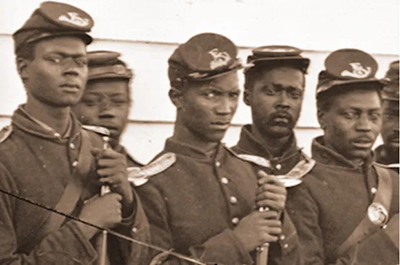
Written by Cass Teague
The 21st Colored Infantry along with the 54th Massachusetts and the 34th and 104th United States Colored Troops held a celebration on May 1, 1865, the first “Decoration Day,” which later became Memorial Day.
What we now know as Memorial Day began as “Decoration Day” in the immediate aftermath of the U.S. Civil War. It was a tradition initiated by former slaves to celebrate emancipation and commemorate those who died for that cause. As the U.S. Civil War came to a close in April 1865, Union troops entered the city of Charleston, S.C., where four years prior the war had begun. While white residents had largely fled the city, Black residents of Charleston remained to celebrate and welcome the troops, who included the Twenty-First Colored Infantry.
Their celebration on May 1, 1865, the first “Decoration Day,” later became Memorial Day. These days, Memorial Day is arranged as a day “without politics”—a general patriotic celebration of all soldiers and veterans, regardless of the nature of the wars in which they participated. This is the opposite of how the day emerged — with explicitly partisan motivations — to celebrate those who fought for justice and liberation.
The concept that the population must “remember the sacrifice” of U.S. service members, without critically reflecting on the wars themselves, did not emerge by accident. It came about in the Jim Crow period as the Northern and Southern ruling classes sought to reunite the country around apolitical mourning, which required erasing the “divisive” issues of slavery and Black citizenship. These issues had been at the heart of the struggles of the Civil War and Reconstruction.
To truly honor Memorial Day means putting the politics back in. It means reviving the visions of emancipation and liberation that animated the first Decoration Days. It means celebrating those who have fought for justice, while exposing the cruel manipulation of hundreds of thousands of U.S. service members who have been sent to fight and die in wars for conquest and empire.
During the spring of 1865, African-Americans in Charleston, South Carolina—most of them former slaves—held a series of memorials and rituals to honor unnamed fallen Union soldiers and boldly celebrated the struggle against slavery. One of the largest such events took place on May first of that year but had been largely forgotten until David Blight, a history professor at Yale University, found records at a Harvard archive. In a New York Times article published in 2011, Blight described the scene.
During the final year of the war, the Confederates had converted the city’s Washington Race Course and Jockey Club into an outdoor prison. Union captives were kept in horrible conditions in the interior of the track; at least 257 died of disease and were hastily buried in a mass grave behind the grandstand. After the Confederate evacuation of Charleston black workmen went to the site, reburied the Union dead properly, and built a high fence around the cemetery. They whitewashed the fence and built an archway over an entrance on which they inscribed the words, “Martyrs of the Race Course.”
The symbolic power of this Low Country planter aristocracy’s bastion was not lost on the freedpeople, who then, in cooperation with white missionaries and teachers, staged a parade of 10,000 on the track. A New York Tribune correspondent witnessed the event, describing “a procession of friends and mourners as South Carolina and the United States never saw before.”
The procession was led by 3,000 black schoolchildren carrying armloads of roses and singing the Union marching song “John Brown’s Body.” Several hundred black women followed with baskets of flowers, wreaths, and crosses. Then came black men marching in cadence, followed by contingents of Union infantrymen. Within the cemetery enclosure a black children’s choir sang “We’ll Rally Around the Flag,” the “Star-Spangled Banner” and spirituals before a series of black ministers read from the Bible.
After the dedication, the crowd dispersed into the infield and did what many of us do nowadays on Memorial Day: enjoyed picnics, listened to speeches, and watched soldiers drill. Among the full brigade of Union infantrymen participating were the famous 54th Massachusetts and the 34th and 104th United States Colored Troops, who performed a special double-columned march around the gravesite.
While historians have gone a long way to expose the white supremacist history of the Civil War and uncover its revolutionary content, the spirit of the first Decoration Day—the struggle for Black liberation and the fight against racism—has unfortunately been whitewashed from the modern Memorial Day.
So let’s use Memorial Day weekend to honor the fallen fighters for justice worldwide, to speak plainly about this country’s historic crimes, and rededicate ourselves to take on those of the present.


Be the first to comment